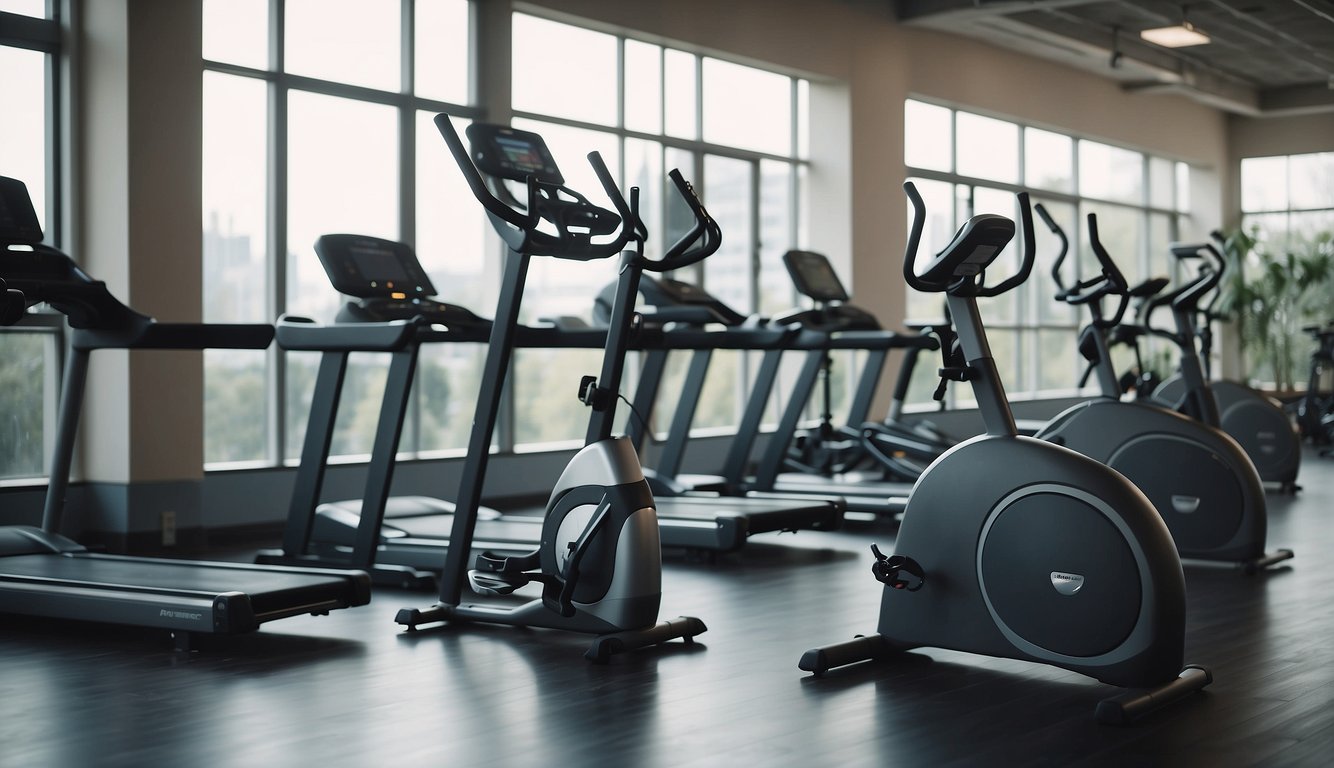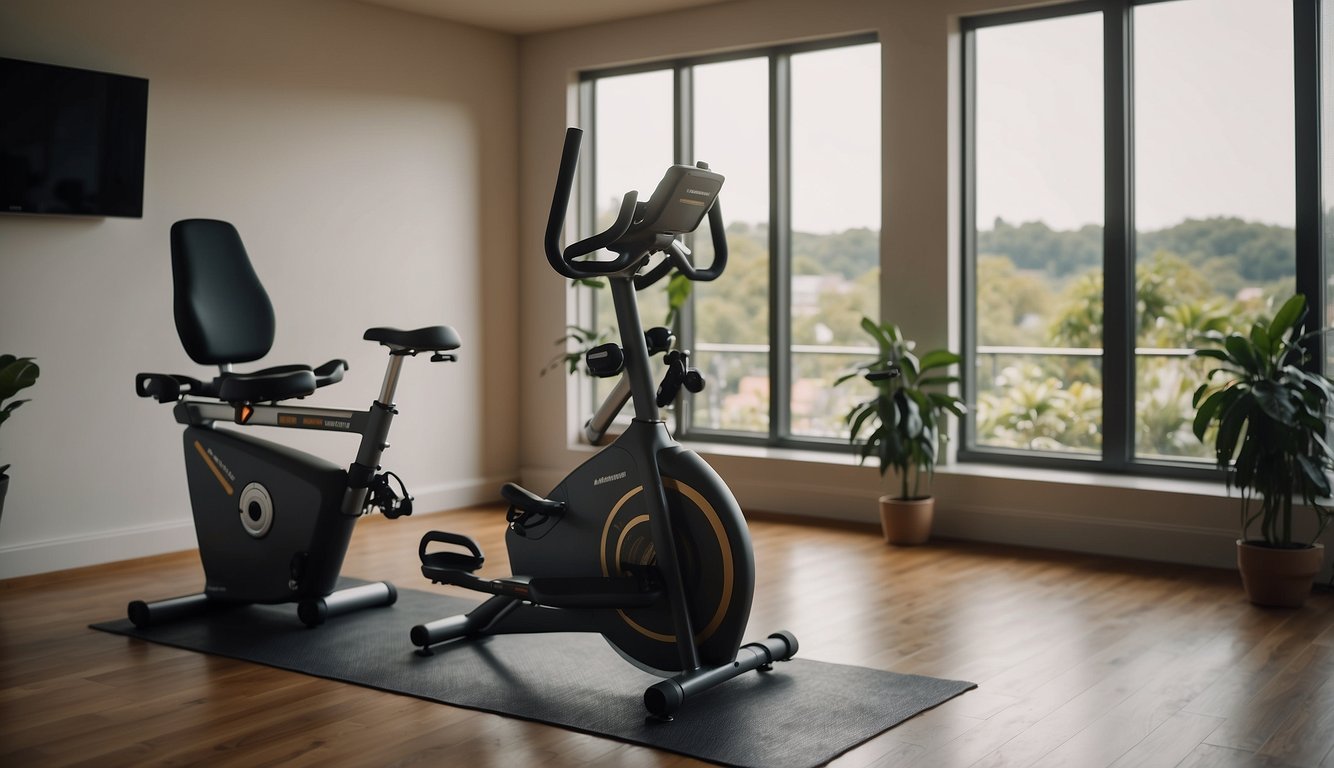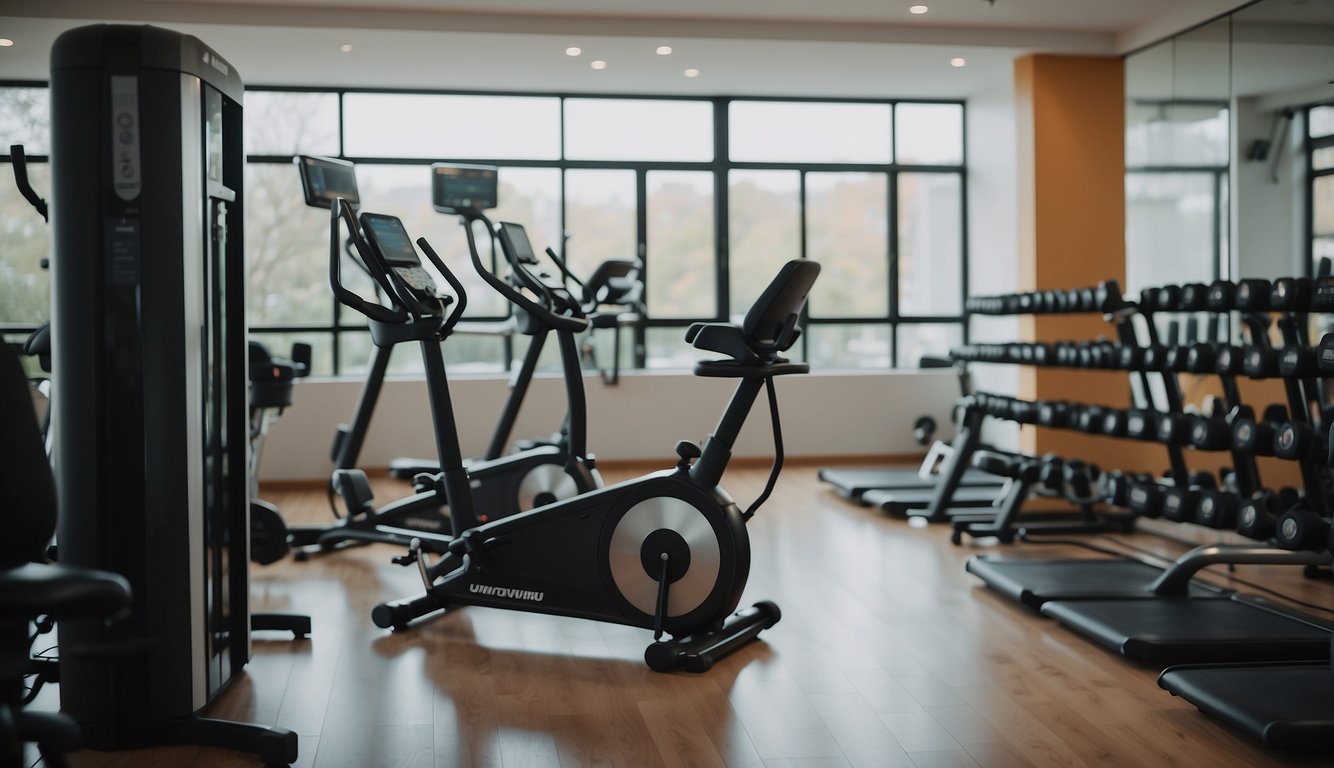Choosing between an exercise bike and a running machine is a common dilemma for individuals seeking to enhance their fitness routine. Both pieces of equipment offer unique benefits and can be integral parts of a cardiovascular workout programme.
The exercise bike provides a low-impact workout that minimises stress on the joints and can be suitable for people of all fitness levels, while a running machine, or treadmill, offers a more high-impact cardiovascular exercise that can simulate natural running conditions.

With health and wellness taking centre stage in many people's lives, understanding the comparative health benefits of these machines is crucial.
Running machines are excellent for weight-bearing exercise, which can strengthen bones and muscles, while exercise bikes can be better for those with pre-existing joint issues.
Furthermore, usage and convenience factors play a substantial role in choosing the right equipment; exercise bikes tend to take up less space and are quieter than running machines, making them convenient for home use.
For those looking to maximise calorie burn, a study highlighted that certain treadmills may have a higher energy expenditure compared to other indoor machines.
Key Takeaways
- Exercise bikes offer low-impact workouts, while running machines provide weight-bearing exercises.
- Running machines may lead to higher calorie burn; however, exercise bikes are better for those with joint concerns.
- Convenience factors such as space and noise level often favour exercise bikes for home use.
Health Benefits Comparison of Exercise Bikes vs Running Machines

The choice between using an exercise bike and a running machine can significantly impact one’s health and fitness goals, addressing specific areas such as cardiovascular health, muscle activation, weight management, and musculoskeletal conditioning.
Impact on Cardiovascular Health
Both exercise bikes and running machines deliver an effective cardiovascular workout, helping to improve heart health and increase stamina. An exercise bike provides a low-impact way to raise heart rate, which is beneficial for individuals with joint issues or arthritis. Meanwhile, the use of a running machine tends to be more intense, potentially leading to greater improvements in cardiovascular endurance over time.
Muscle Group Activation
When comparing muscle activation, using a running machine generally involves more of the body’s muscle groups, including the core, and can lead to enhanced lower body strength. On the other hand, an exercise bike primarily targets the quadriceps, hamstrings, calves, and glutes. It offers a focused workout that can strengthen these specific muscle groups with less stress on the knees and ankles.
Weight Loss and Calorie Burn
Regarding weight loss and calorie burn, a running machine might have the upper hand due to its high-intensity nature. It can lead to higher calorie expenditure, aiding in weight loss for those looking to lose weight effectively. However, an exercise bike can still offer substantial calorie burn, especially in higher intensity settings or during spin classes.
Bone Health and Injury Prevention
For bone health, running machines provide a weight-bearing exercise which is beneficial in preventing osteoporosis. However, they can put more strain on the joints, increasing the risk of impact-related injuries. Exercise bikes, being low-impact, significantly reduce the risk of injury and are a safer option for those with joint issues or are managing conditions like arthritis.
Types of Bike and Running Exercises and Their Effectiveness

Selecting the right type of exercise equipment can significantly impact one's fitness outcomes. This section reviews the various benefits of exercise bikes and running machines, spanning aerobic and anaerobic output, strength and toning prospective, along with impact level considerations.
Aerobic vs Anaerobic Benefits
Exercise Bikes offer an efficient way to achieve aerobic exercise, enhancing cardiovascular fitness. They are convenient for maintaining a steady heart rate in the fat-burning zone.
In contrast, Running Machines can be employed for both aerobic and anaerobic training. By adjusting the speed and incline, one can alternate between prolonged, steady-state runs for endurance and high-intensity sprints that benefit anaerobic capacity.
Strength Training and Toning
Although primarily considered cardio equipment, exercise bikes can help with strength training, especially in the lower body. The resistance feature on bikes emulates hill climbing, building muscle in the calves, thighs, and glutes.
Conversely, running machines often provide a full-body workout and can enhance core strength. Additionally, they stimulate a broader range of leg muscles, offering an overall toning effect.
High-Impact and Low-Impact Exercises
Running Machines generate high-impact exercise, which can strengthen weight-bearing bones but may be problematic for individuals with joint issues. The high-impact activity of running places more stress on the body compared to low-impact cycling.
Exercise Bikes are gentler on joints, making them ideal for recovery days or for those with existing joint pain. They can also provide an effective workout with a reduced risk of injury.
Physical Impact and Risks of Exercise Bikes vs Running Machines
When evaluating exercise bikes versus running machines, one should consider the potential physical impacts on the body and the associated risks of injury. Each piece of equipment has distinct implications for joint stress, spinal alignment, and injury potential.
Joint Stress and Pain Management
Exercise bikes are generally associated with lower joint stress, making them a favourable option for those with joint concerns or chronic pain. They provide a low-impact cardiovascular workout that reduces the strain on knees, hips, and ankles.
In contrast, running machines can contribute to higher impact on joints; however, many are designed with cushioned decks that aim to absorb shock and mitigate pain.
Lower Back Support and Alignment
Regarding back pain, an exercise bike can offer substantial support, particularly in recumbent models where one's back is reclined and supported throughout the exercise. This may reduce the risk of lumbar (lower back) strain. Treadmill users, conversely, do not receive the same level of back support, which can lead to poor posture or alignment issues during high-impact exercises.
Risk of Falls and Injuries
Running machines carry an inherent risk of falls due to the moving belt, requiring users to maintain balance and coordination throughout their workout. Proper use reduces this risk but does not entirely eliminate it. Exercise bikes, being stationary and with no moving walkway, tend to present less risk of injury from falls.
However, both types of equipment should be used with care, maintaining proper form to prevent injuries such as muscle strains or fractures. It's important to note that for individuals with conditions such as osteoporosis, the choice of exercise equipment should be carefully considered with a healthcare professional to prevent fractures due to falls or severe impacts.
Running Machine vs Exercise Bike - Usage and Convenience Factors
When selecting between an exercise bike and a running machine, one must consider the size of the space required, the ease of setting up and maintaining the equipment, and how each option fits into an individual's lifestyle for accessibility and versatility.
Space and Equipment Size
An exercise bike generally occupies less floor space compared to a treadmill, making it a more compact choice for home use. The footprint of a standard exercise bike is about 0.6 by 1.2 metres, while treadmills typically require about 1.8 by 1 metre of space. In commercial gyms, space may not be as much of a concern, but for those looking to make an investment for their home, size matters.
Ease of Setup and Maintenance
Treadmills, with their larger size and more complex parts, may require a longer setup time. They also tend to need regular maintenance, including belt lubrication and alignment checks. Exercise bikes, on the other hand, usually have fewer moving parts, resulting in a simpler setup and potentially lower ongoing maintenance needs, which is particularly appealing for individuals with a limited budget or time constraints.
Accessibility and Versatility
Both treadmills and exercise bikes are widely available in commercial gyms, but for home use, the exercise bike often offers greater versatility. It’s easier to move, can sometimes be used while watching TV or reading, and is accessible to people of various fitness levels. Treadmills offer the benefit of weight-bearing exercise, which can be more effective for building bone density, but may not be as suitable for those with joint issues.
Fitness Goals and Workout Routines
Selecting the right equipment for your fitness journey depends on your personal goals and the types of workout routines you prefer. Whether you're considering an exercise bike or a running machine, it's crucial to tailor your choice to what best aligns with your fitness aspirations.
Routine Setup and Flexibility
Creating a workout routine with an exercise bike offers high flexibility. Cyclists can engage in steady-state cardio or high-intensity interval training (HIIT) that effectively builds cardiovascular fitness.
For example, Peloton bikes allow users to follow live and on-demand classes that fit into any schedule. In contrast, running machines facilitate walking, jogging, or sprinting at various inclines and speeds, which can be adjusted to suit the user's fitness level and routine preferences.
Targeting Specific Fitness Outcomes
Both exercise bikes and treadmills can be utilised to achieve specific fitness outcomes. High-intensity interval training on a treadmill might be preferred by those looking to enhance their running performance and calorie burn. Meanwhile, exercise bikes are particularly beneficial for low-impact, fat-burning workouts that are easier on the joints. Stationary bikes also allow users to concentrate on leg strength and endurance, an essential aspect of overall fitness.
Integration with Fitness Apps and Programs
Modern exercise equipment often integrates seamlessly with fitness apps and programs, providing a comprehensive workout experience. For instance, exercise bikes like Peloton synchronise with their proprietary app to track progress, and join a community, promoting motivation through collective participation. Treadmills are not far behind, with connectivity allowing users to track their stats over time or immerse themselves in simulated environments to enhance the running experience.
Economic Considerations
When selecting an exercise machine, the buyer must consider both the initial financial outlay and the ongoing costs associated with the equipment. Understanding the value for money and the potential for the equipment to be a long-term investment is crucial to making an informed decision.
Upfront and Ongoing Costs
Exercise Bikes:
- Cost Range: Budget exercise bikes may start from around $200 AUD, while higher-end models can exceed $2,000 AUD.
- Maintenance: Generally low maintenance; occasional lubrication and tightening of moving parts required.
Running Machines:
- Cost Range: A basic treadmill can cost from $500 AUD, with premium models reaching up to $5,000 AUD or more.
- Maintenance: Greater potential for wear and tear leading to higher ongoing maintenance costs; belt adjustments, motor care, and deck lubrication are common.
Value for Money and Long-Term Investment
Exercise Bikes:
- Duration: Typically have a longer lifespan due to fewer mechanical parts subject to wear.
-
Investment:
- Economy Model: Adequate for low-intensity workouts; may lack advanced features.
- Premium Model: Durable and equipped with features such as heart rate monitors and workout programs.
Running Machines:
- Duration: Dependent on the quality of components and maintenance; more complex mechanisms can lead to earlier replacements.
-
Investment:
- Economy Model: Suitable for walking or light jogging; limited features but sufficient for basic cardio workouts.
- Premium Model: Offers robust build quality and technological integration for a more varied training regimen.
Buyers should align their selections with their budget and fitness goals to ensure the exercise machine represents a sound investment. Each option presents a unique profile of costs and benefits that will play a significant role in the user's long-term fitness journey.
User Experience and Community Support
When it comes to deciding between an exercise bike and a running machine, two central aspects shape a user's decision: their satisfaction with the product and the support they receive from user communities.
Overall User Satisfaction
Users typically gauge their satisfaction with exercise equipment based on ease of use, comfort, and the quality of workouts it can provide. Exercise bikes, especially models like Peloton, are acclaimed for their interactive classes and robust build, offering a diverse range of programs catering to all fitness levels.
On the other hand, running machines provide a more natural exercise for those accustomed to jogging or walking, with many commercial gyms providing advanced treadmills that simulate various terrains.
With applications integral to the user experience for smart equipment, Peloton's app is a standout for its immersive experience, while many running machines also sync with apps to track progress and provide virtual running environments.
Support and Advice from User Communities
Communities play a crucial role in maintaining motivation and offering assistance. Peloton has cultivated a strong community, where users can find support and camaraderie through live classes and community challenges. Exercise bike users frequently tap into these communities via the app, fostering a sense of belonging and shared purpose.
In contrast, the user communities for running machines are often centred around commercial gyms and online forums. While they may lack the integrated platform approach of Peloton, these communities are invaluable for exchanging tips, mutual encouragement, and advice on workout routines and machine maintenance.
Environment and Workout Conditions
Choosing between an exercise bike and a running machine often depends on one's preferred exercise environment and the conditions one wishes to simulate. These machines offer control over workout variables and can cater to individual environmental preferences and training requirements.
Indoor vs Outdoor Preferences
Individuals who prefer to train indoors may find an exercise bike or running machine suitable for avoiding the unpredictable nature of outdoor terrain and weather. The controlled climate of an indoor setting allows users to maintain a consistent exercise routine regardless of external temperature and weather conditions, which can be particularly beneficial in regions with extreme weather.
Adjustable Conditions and Resistance Levels
Exercise bikes and running machines offer various settings to manipulate resistance and incline, providing users with the ability to simulate different terrain and environmental conditions. They can also easily control the temperature of their immediate surroundings.
On exercise bikes, resistance levels can mimic the effort required to cycle uphill, while running machines can emulate an incline, giving the impression of running on a hill. Both types of equipment allow for a tailored workout that can adjust the intensity and simulate preferred environmental challenges.
Frequently Asked Questions
Deciding between an exercise bike and a treadmill for fitness goals is a common dilemma. The following FAQs address the differences in effectiveness, suitability for different individuals, and impact on the body.
Which is more effective for weight loss, a treadmill or an exercise bike?
Both treadmills and exercise bikes are excellent for burning calories, which is crucial for weight loss. However, typically a treadmill may lead to higher calorie burn due to the potential for higher intensity workouts, although the actual effectiveness will depend on the individual's workout intensity and duration.
Can using an exercise bike reduce belly fat as efficiently as running?
An exercise bike can help reduce belly fat by providing aerobic exercise that burns fat overall, but targeted fat loss in one specific area, such as the belly, is not possible. Consistency and a healthy diet are key to efficient fat reduction, just as with running.
What are the benefits of a treadmill versus an exercise bike for improving leg tone?
Treadmills may offer a more comprehensive lower body workout as they engage the hamstrings, quadriceps, calves, and glutes during the running or walking motion. The resistance from an exercise bike also targets the legs and may improve tone, but may not offer the same range of muscle engagement.
For individuals with knee problems, is an exercise bike or a treadmill a better option?
An exercise bike is generally the preferred option for those with knee problems as it offers low-impact exercise, reducing stress on the knees compared to the impact of running on a treadmill.
How do treadmills and exercise bikes compare in terms of their impact on hip joints?
Treadmills can be more demanding on the hip joints due to the impact associated with running or walking. In contrast, exercise bikes provide a smoother motion with less impact on the hips, making them a suitable option for individuals concerned about hip joint stress.
Which is a suitable option for seniors seeking low-impact exercise: a treadmill or a stationary bike?
For seniors seeking low-impact exercise, a stationary bike is often the better choice. It presents less risk of falls, provides support for the back, and places less strain on the joints compared to a treadmill.









